
Google Ads is an online advertising platform provided by Google that allows businesses and advertisers to display their ads on Google’s search engine results pages (SERPs), websites within the Google Display Network, YouTube, and various other Google partner sites. It is a pay-per-click (PPC) advertising system where advertisers bid on keywords and pay for their ads when users click on them.

Responsive search ads let you create an ad that adapts to show more relevant messages to your customers. Enter multiple headlines and descriptions when creating a responsive search ad, and over time, Google Ads automatically tests different combinations and learns which combinations perform best.
Performance Max is a new goal-based campaign type that allows performance advertisers to access all of their Google Ads inventory from a single campaign. It’s designed to complement your keyword-based Search campaigns to help you find more converting customers across all of Google’s channels like YouTube, Display, Search, Discover, Gmail and Maps.

Discovery ads appear in places where people are most likely researching products or watching product reviews including the YouTube homepage for example. Google users can opt out of the data that’s tracked to put together targeted Discovery Ads, but most people don’t and Google claims it can reach up to 3 billion users. Google does this by tracking users:
A display ad is a type of online advertisement that displays images or videos that appear across millions of websites worldwide that are part of Google’s Display Network, e.g YouTube, appearing on third-party websites.
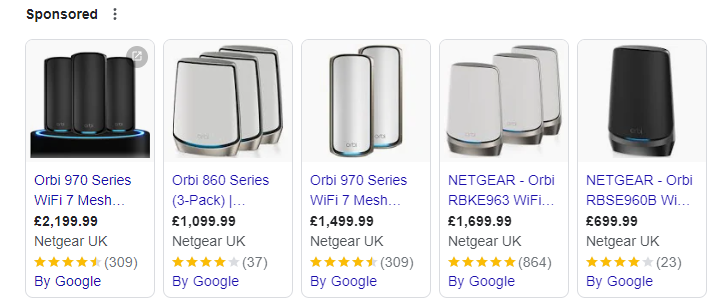
Shopping ads use your product catalogue to showcase e-commerce optimised ads across the Google Search and Display networks. Google’s automatic targeting shows what it thinks is the most relevant product for a user’s search Google shows product listings – both ads & organic results in an e-commerce inspired layout that’s easy to browse, click through, and buy. Example:
This article is part of our blog series, Websites 101, lightly introducing and explaining important topics on everything to do with websites, including design, digital marketing, software, infrastructure and beyond.
If you have a question you want answered as part of the Websites 101 blog series? Get in touch to let us know.
Updated February 2024
Google uses the page experience as part of their ranking algorithm, making it yet another factor to keep on top of to achieve a high position in the search results.
Google have grouped these under the title of Core Web Vitals, to provide a snapshot health-check of your site – but crucially it can use real visitor data.
Core Web Vitals are metrics introduced by Google to measure real-world usage of a visitor’s experience on a webpage. They comprise three primary measurements that are used to calculate the speed of the page and user interaction.
The Core Web Vitals are:
Not exactly snappy titles and not immediately obvious what they are. Strap in, here we go:
Largest Contentful Paint is simply the measurement of how long it takes a page-view to load for a real site user. So, from the point of clicking a link to seeing the site on your screen, Google tells us this should happen in under 2.5 seconds.

To analyse LCP, Google takes the largest content piece (be it text, video or image) to appear on the display. As the page changes in loading, Google shifts to the new main element. It progresses until when the page loads fully or the user starts interacting with the page. There are several elements that that can impact the loading speed, but the main factors for enhancing LCP include:
LCP is primarily going to be impacted by how your site was built in the first place, or what content you’ve added to it since, but from a site owner’s point of view making sure that images are correctly compressed for web use is important, either before uploading to the site or making sure the site itself is applying compression.
Cumulative Layout Shift calculates the visual stability of a page as it loads. Layout shift, also known as ‘layout jank’, appears when the information on the page keeps moving around despite the page appearing loaded. This is annoying, and can sometimes result in a user clicking the incorrect link.
The CLS score is calculated through multiplication of the display part that changed when loading by the interval it moved. Google’s recommendation is a score under 0.1, so only minimal elements move as the page loads.

Again, layout shift is going to be mainly influenced by how the site was originally built.
Largest Contentful Paint measures if the page is viewable. First Input Delay measures whether a user can interact with the page, such as clicking a link. Often a page can be viewable, but due to the loading of other items happening off-screen you can’t interact with the page.
Longer input delays tend to happen when the page is in the loading process and part of the content is already viewable but expecting to be interactive, since the browser is fully engaged in loading the remaining part of the page. The primary effort on developing FID is concentrated on quicker page loading.
Google rates a score under 100 milliseconds as Good for FID.

Implementing a site cache (such as Cloudflare) and reviewing slow 3rd party JavaScript can rapidly reduce your first input delay score.
From March 2024, Google will be using Interaction to Next Paint (INP) instead of FID (First Input Delay). INP assesses the responsiveness of using a webpage, such as clicking or a key press, and how long it takes for the user interface to update. When an interaction causes a page to become unresponsive, that is a poor user experience. INP observes the latency of all interactions a user has made with the page, and reports a single value which all (or nearly all) interactions were below. A low INP means the page was consistently able to respond quickly to all—or the vast majority—of user interactions.

PageSpeed Insights
The easiest way to view your vitals is via Google’s PageSpeed Insights. In the results, some sites will have a Field Data section, but this is usually only for larger sites.
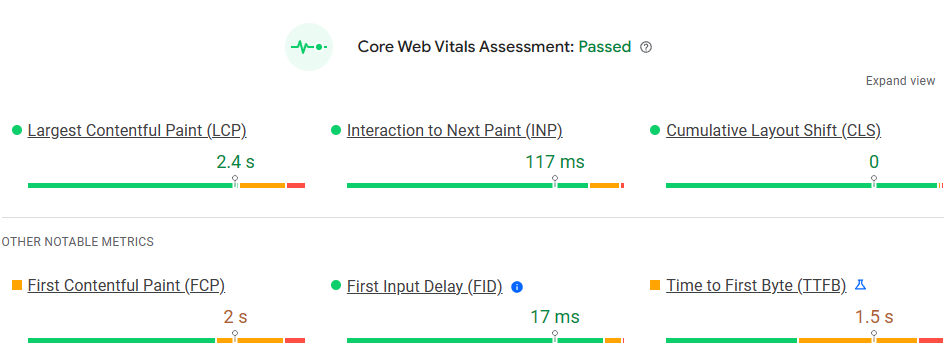
If Field Data isn’t shown, you can still see a snapshot underneath from Lab Data. Note that running the report multiple times for the same page can get different results.

Google Search Console
For a more detailed view of Core Web Vitals, you will need to access Google Search Console. This will provide a graph of the number of pages with issues or improvements required over time, split between mobile and desktop.
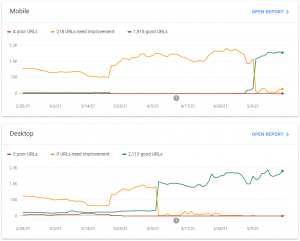
Selecting the Open Report against these graphs then allows you to see what the issues relate to. Selecting any of the Types in the details section will show which pages are affected.
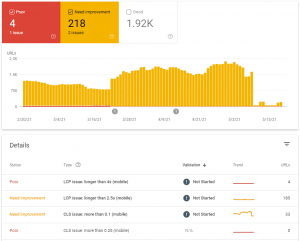
Google uses PageSpeed Insights as a tool for testing website performance.
A Google PageSpeed Score typically ranges from 0 to 100 with a higher score indicating better performance. The score is calculated based on how a page performs in terms of various performance metrics. The specific algorithm and weightings may change over time, but it generally takes into account factors like page load times, content rendering, and interactivity.
The PageSpeed Score is often linked to the user experience. A higher score usually correlates to faster loading and better user experience. Google and other search engines consider page speed and user experience when ranking pages in search results, so a better score can lead to improved search engine ranking and user engagement.
An overall Speed score is calculated by looking at the categories for each metric:
We could equate Core Web Vitals to emissions tests during your car’s MOT. It’s measuring multiple areas all designed to improve the quality of the environment or in this case the internet. As Core Web Vitals are now being used by Google as part of their ranking algorithm, for those sites wishing to stay on top of their search engine positions it’s going to be important to monitor them and make sure that your site stays in tip-top condition.
How does Google see your website? What are your site’s top performing pages? Which keywords are people using to find your site? What’s needed to improve your website’s performance?
Google Search Console is the free tool that helps you get to the root of these questions. Here are the need-to-knows for understanding and making the most of the product.
Google Search Console is a free product designed to help website owners monitor the performance of their website in Google Search results.
Formerly known as Google Webmaster Tools, it helps measure organic search engine listings such as keyword rankings, as well as any issues reported by the search engine that can be used to improve the website’s performance.
The information provided can help a site owner understand how they’re doing in Google Search. It also informs anyone who directly works on the site – be that an agency like Infotex or site owners and administrators – how to troubleshoot issues and improve performance.
If you have a website with Infotex, then it is very likely that your site is already registered with Google Search Console. You can contact your Account Manager or the Support Team if you wish to be added as a user to the Google Search Console service.
Otherwise, sign up to Google Search Console to verify your ownership of your website and get going.
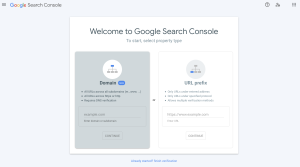
Once logged in to Google Search Console, you are presented with a left hand menu of sections including:
Overview: Provides a summary of your site performance and indexing in Google.
Performance Reports: Displays how many people saw and clicked on your site in Google Search, as well as your website’s average position in Google search rankings. This information can be seen for both keywords and for individual site pages, so it is an important tool for understanding the search terms people are using to find your site and the content that is being seen most in search results.
Page indexing: A report which shows all pages on your site that are known to Google, along with whether each page is or is not indexed in Google, and the reasons for this.
Page experience: This report isn’t about what some would typically associate with Google Search. Page experience reports on how “good” a page is in terms of other factors like loading speed and mobile experience. As Google’s ranking algorithms have become more and more sophisticated, these experience metrics have become more important for Search Engine Optimisation.

Google Search Console is a vital tool for any Digital Marketer for both troubleshooting and understanding a site’s performance. It’s well worth a look, even if you’re just wanting an overview of what keywords your site is being found for.
This article is part of our new blog series, Websites 101, lightly introducing and explaining important topics on everything to do with websites, including design, digital marketing, software, infrastructure and beyond.
Got a question you want answered as part of the Websites 101 blog series? Get in touch to let us know.
The online food and drink sector is a fast-changing and competitive market, so it is important to continuously review and revise your online marketing. At Infotex we support our clients with the best Search Engine Optimisation (SEO) and digital marketing practices to help their websites keep up with the market.
Read on to learn how we support our food and drink clients with digital marketing strategies, and for examples of clients’ food and drink websites.
Support comes in many forms, but on the digital marketing front there are three essential strategies we know are most effective for driving traffic to websites in the food and drink sector.

Through our SEO and digital marketing practices, we have been able to attract higher numbers of traffic for our client’s websites.
This includes targeting keywords and queries related to the industry (such as ‘food for camping’), bespoke marketing campaigns, and introducing paid advertising via Google Ads.
The increased exposure allows our clients to offer their food and drink products to a wider audience.

Through keeping an active and regularly updated blog, food and drink websites attract more visitors to the site because they are providing frequent content for people browsing their related products. Consistently posting new and high-quality content reassures potential customers that the website is active and they care about keeping loyal customers updated regarding the latest developments of the company.
Producing interesting articles that capture the attention of page visitors will only benefit food & drink companies, and with our digital marketing and SEO services we can carry out the required action and practices to make it as visible to potential viewers as we possibly can to increase brand exposure.

We provide our clients with monthly reports to keep them informed regarding activity on their website Through analysis of this data we then decide how and where to focus effort to continually improve the site, by implementing the correct marketing campaigns and strategies.
Here’s a snapshot of some of our food and drink clients who are taking the market by storm.
Due to the impact of COVID-19, Niche had to quickly alter their business strategy after launching in February 2020. Their original plan was to target pubs, restaurants, hotels, and event caterers as their primary market, providing a convenient alternative to having an onsite mixologist. However, when lockdowns were enforced and they found themselves with excess inventory, they established an online store and shifted their focus to roles such as picking, packing, and delivering orders.
To set up the online store, Niche enlisted the help of Virtue Design to create a website and Infotex to implement it onto the Shopify ecommerce platform. This allowed for a speedy setup process while still retaining the flexibility to utilize various apps and add-ons for added functionality. Through a Facebook advertising campaign, the site was promoted to attract new customers from across the UK. The site is also integrated with a newsletter system, allowing Niche to easily communicate with their customers via email.
Scarlett & Mustard is a British food company that produces a range of artisanal condiments and dressings. The company was founded by Sandy Ruddock and Julian Pollard in 2012, and since then gone on to gain a reputation for high-quality, locally sourced ingredients and unique flavour combinations.
Some of their most popular products include their Great Taste award-winning dressings, including the tangy and zesty Lemon & Mustard Dressing and the rich and savoury Sticky Fig & Onion Balsamic Dressing. Scarlett & Mustard also produces a range of chutneys, pickles, and sauces, all made with the same commitment to quality and taste.
With their emphasis on small-batch production and attention to detail, Scarlett & Mustard has become a favourite among foodies and gourmet enthusiasts alike.
With a range of ready-to-eat packs that are simple to use, Wayfayrer provides tasty, balanced, and nutritious meals, making them the perfect choice for camping trips. These meals have a proven track record, tracing back to the MRE rations (Meal – Ready to Eat) supplied to the British army for over 30 years.
Wayfayrer draws inspiration from the army ration range, which includes cuisines from around the world, to create their selection of delicious camping food. As the official food for the Duke of Edinburgh Award Scheme, Wayfayrer meals are of the highest quality standards and offer a range of tasty breakfasts, main meals, and desserts to help fuel your passion for adventure and prepare you for the challenges ahead.
For more examples of food and drink websites visit our work.
Need help marketing your food and drink website? Get in touch today.
If you’re thinking about how to help your law firm engage with the right people online, there are many adjustments you can make to your website.
A good way to start thinking about how to improve your website is to look at the competition. Using examples from current leading family law websites, here are our top tips for how to get your website working well for you.
Endavour Law Solicitors, who specialise in divorce, drive a large amount of traffic to their site through organic keywords. They rank well for ‘cheap divorce’, which would likely bring them a lot of visitors.
Organic keywords are words and phrases that freely attract visitors to your site through search engine optimisation (SEO). By incorporating relevant organic keywords into the page titles, headings, meta titles and descriptions, and the body text of your general site, you help search engines like Google understand what your website and page is about, making it more likely to rank the pages higher up the search engine results pages (SERPs). Therefore, when someone searches something relevant to your services, they will be more likely to find your site.

Rayden Solicitors, who advise on all aspects of family law, get a significant number of organic traffic through the keyword ‘grandparents rights uk’.
Other widely successful organic search phrases for family law websites are those that include ‘near me’. For example, Sills & Betteridge Solicitors see a large amount of traffic from the search ‘solicitors near me’. Major Family Law Solicitors, too, saw a large amount of traffic from the search ‘Divorce lawyers near me’. For this reason, it’s important to always keep your firm’s location and address updated on search engines, such as by adding your business to Google Maps.
Often websites will drive a lot of their traffic via targeting specific keywords.
While organic keywords serve to optimise your website’s search engine rankings through making it more relevant to users, PPC keywords are different because they require bids in auctions in order to acquire, with popular keywords being more expensive and with a higher CPC (cost-per-click). The advertising law firm will pay a fee whenever someone clicks on an ad that takes them to the website.
This includes Google Ads, which is Google’s pay-per-click solution. Paid search positions through Google Ads help a great deal for certain websites to become visible on the Google results page.
For family law websites, the most popular and expensive keywords include: ‘divorce’, ‘family law solicitors’, ‘divorce solicitors’, ‘family lawyer’, etc.
Stowe Family Law ranks number one in Google ads PPC for ‘family law’, and second in the Search Engine Results Pages (SERPs). Example key terms for Stowe Family Law include: ‘what is cohabiting’, ‘stonewalling’, and ‘divorce solicitors’.

The Endeavour Law Solicitors website ranks as the second Google Ad in the SERP for a ‘family law’ search. Their top paid keywords are ‘divorce’, ‘no win no fee’, and ‘solicitors near me’.
If the website is active and regularly updated with fresh and new content, then Google will notice this and favour it over those that aren’t. FAQs and information blogs are examples of effective ways to keep your content relevant and fresh.
Stephens Scown, who we work with, get traffic to their website through regularly updating the Info Hub on their website with engaging content.
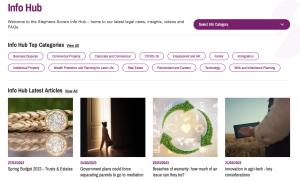
It sounds obvious, but content quality has a major influence on the Google ranking, along with whether the content is relevant or related.
Backlinks and referrals demonstrate to search engines like Google that your website has authority, especially if other high-authority domains are linking to it. It’s an important SEO feature for any website that wants to rank well.
Domain authority is a search engine ranking score developed by Moz.com that describes a website’s relevance for a specific subject area or industry. This relevance has a direct impact on its ranking by search engines.
An example of good user journey is The Family Law Company, another company with whom we’re proud to work.
It is one thing to get users to your website, but you also have to keep them there! Positive user-experience on websites is very important. This includes the website being simple to navigate and browse, which leads to positive reviews and more likely to attract visitors.
This helps user click-through-rate, another very important factor when it comes to SEO ranking as it gives a good indication of the quality of the website, as do other indicators such as bounce rate (the number of visitors that leave after viewing one page).
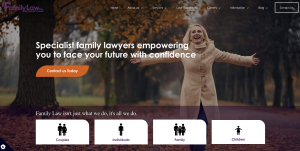
As the majority of website users are now mobile users, it is imperative that a website is also mobile user friendly, meaning that it is easy to navigate via mobile.
A sitemap helps search engines discover URLs on your site. However, it doesn’t guarantee that all the items in your sitemap will be crawled and indexed. Nonetheless, in most cases, your site will benefit from having a sitemap.
If you have questions on how to optimise your law website, don’t hesitate to get in touch with our team.
Providing your potential website customers with an easy to use, stress-free, but informative checkout can improve your conversion rate and reduce time spent responding to customer’s questions.
The checkout is one of the most important sections of the website. It’s an essential part of a customer’s journey, and their decision to proceed with or abandon a purchase can be heavily influenced in just a few clicks.
I’ve looked at a few options to consider implementing to improve your checkout.
Customers are no longer just looking for free delivery, though this can be a key driver in sales. Many are now actively looking for sites which use couriers they are satisfied with. There is always a balance between delivery cost and service, but we’ve seen sites that offer the consumer the choice of courier so they can pick the one that operates best in their area. Not only that, there are benefits of allowing the customer to pick the day the item is delivered on – at a fee of course.
By offering this choice a huge amount of trust can be gained, though it can cause logistical challenges. Your site management has to be on-point as well, to avoid publishing bank holidays as available dates etc.
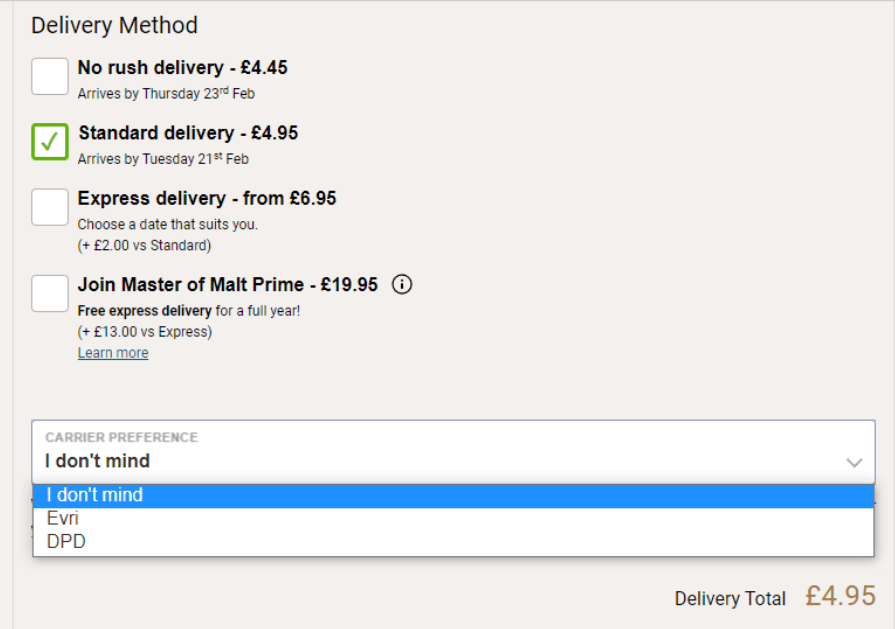
One of the best examples of delivery choice I’ve seen is from Master of Malt. The multiple delivery options are all clearly labelled and priced. They even allow the customer to select their carrier.
With any delivery section two things are key to clearly publish:
‘Hidden’ fees during a checkout can cause a high rate of abandonment. It’s not just the checkout’s job to communicate these items either – having them stated clearly on the product page and influence visitors to start the checkout process. Many sites now show a countdown timer to when you have to order by in order to receive delivery for a certain date. While some may see this as gimmicky and applying artificial pressure on consumers, it’s also providing valuable information on the product page.
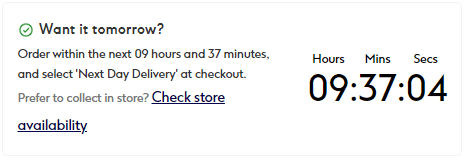
Boots.com shows a countdown timer on their product page showing how you can get next day delivery.
The days of customers only having a credit or debit card are long gone. Customers have different preferences, and providing a choice of payment options allows them to pick their preferred method. So called ‘accelerated’ payment methods like Apple Pay or Google Pay are incredibly popular as they allow a near 1-click checkout experience.
If you have regular repeat customers then providing a way for them to save their payment details for future use can be of benefit. Or even investigate automated repeat ordering – i.e. subscriptions – as a way for regular revenue.

ASOS.com provides a range of popular payment methods
Buy Now / Pay Later (BNPL) can also be worth the investment, especially for higher ticket items. Adobe Analytics found that 12 per cent of online purchases made in the UK in January 2023 were made with BNPL. Klarna, ClearPay and PayPal offer methods for customers who wish to spread their payments, and Apple’s Pay Later will be hitting the internet “soon” according to CEO Tim Cook [as of Feb 2023]. However, legislation is currently being drafted in the UK which will likely alter what lenders can offer.
During the checkout you might want to find out as much about your customers as possible, but the more you ask the more likely the abandonment rate will increase. For example, asking a customer where they heard about you isn’t a good idea during the checkout as a user has to stop and think. (Asking for this in a post order feedback survey or ad-hoc questionnaires would be better). Any information that can not be reasonably associated with the essential info for purchasing is best left off.
A big turn-off for consumers is being forced to make an account before they can checkout. Ideally integrate the account registration process into the checkout – many will ask if a user wants to create an account after they have placed an order.
Not everyone who starts the checkout process will finish the checkout process. Even the most successful sites will have abandoned baskets, sitting in a virtual pile gathering digital dust.
There are a few things you can do to try and tempt them back – if they were logged in or had provided an email address you could send a follow up email a few hours after their basket becomes inactive asking them back to the site.
You could also set up remarketing ads, which will show the visitor what product(s) they were going to purchase on ads as they navigate through the internet. This can help to keep your brand front and centre of the consumers mind while they make the decision to buy or not.
Google Analytics is a (usually) free web tracking tool, and the most popular visitor analytics service. It tracks users across websites it is installed on, and provides data on how people are using and interacting with the site. The majority of websites that use Google Analytics are using Universal Analytics.
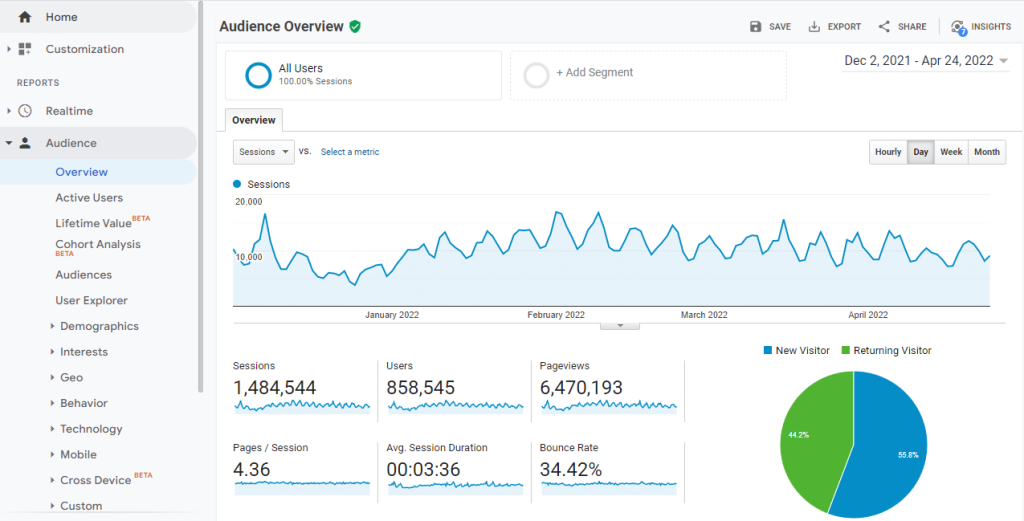
In October 2020 Google launched Google Analytics 4, and in March 2022 Google announced that Universal Analytics (sometimes called GA3) will no longer process new data from 1st July 2023. This leaves just over one year to make the transition to Google Analytics 4. After this date, Google’s analytics solution for websites will be Google Analytics 4.
Google Analytics 4 marks a large shift in terms of both measurement and reporting moving from session based to event based. The new version is cited as privacy-focussed, as it will eventually become a cookie-less solution and as standard has IP anonymization on by default. It will also utilise machine learning to fill in the gaps of web users who opt-out of cookie tracking and help make predictions on your data.
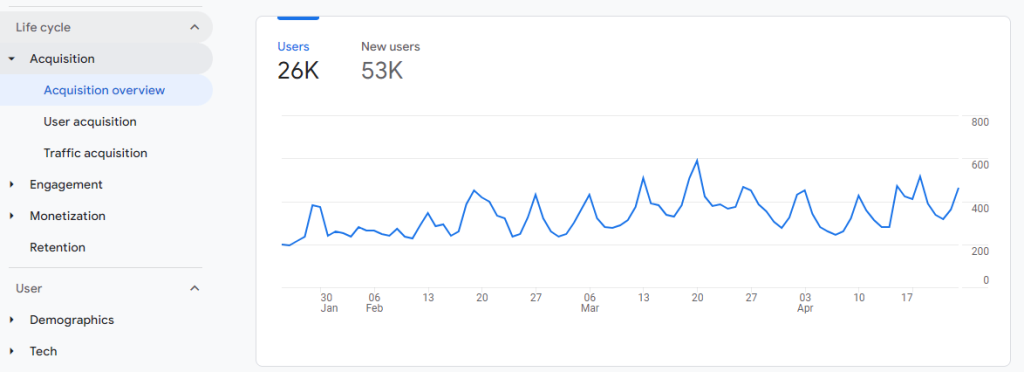
This change in measurement from session based to event based means much of the existing reports and metrics in the current interface are either removed or replaced. Don’t expect to see the same reports that you’re used to. While some data is lost from moving away from session based data, the new event model includes certain events being measured automatically including scroll tracking, outbound clicks (clicks to other sites), file downloads and video engagement.
In the period between now and July 2023 we are recommending sites implement the new GA4 version of Analytics and run this in parallel with their Universal Analytics. This gives a window of time to not only get used to the new version, but also to collect data to allow date comparisons for reporting. If you’d like to get a taste of what the new Google Analytics 4 reporting tool looks like you can access Google’s Demo Account.
Currently, GA4 feels a little way off from becoming the web’s primary analytics tool but we expect to see it grow in functionality and popularity as the July 2023 date nears. However, GA4 is the next generation and in 2023 and beyond it’s a tool we will all be using a lot more.
If we’re working with you on marketing and reporting and you’re not already on GA4, we’ll be in touch to discuss making the transition. If you’d like more information about GA4 or to discuss getting started with GA4 on your website, please do get in touch with us.
Even if you’re not an online retailer, getting prepared for the Christmas season should start early.
It’s a stressful time for everyone, but this is just a small reminder to get ahead of the game and make the most of it.
SEO is the process that ensures your website ranks as highly as possible in organic search engine results. This improves traffic to your website and attracts relevant consumers to increase conversion rates.
Most people involved with SEO are predominantly concerned by Google’s ranking algorithms, as Google is by far the most popular search engine.
Search engine rankings are based on a series of algorithms that take into account numerous factors to deliver the most relevant, safe and accurate results to a search engine user. Google Search algorithms determine the results of a search query by looking at the relevance, quality, usability, and context of a site, and each factor is weighted differently depending on the user query.
These algorithms never sit still. Search engines are always looking for the next best way to serve you the highest quality results for your search. So, SEO that worked for you in 2014 would fail in 2021. No one can know Google’s exact algorithms, but you need a team with their ears to the ground at all times, looking for these changes, to ensure search performance security.
On-site SEO refers to the optimisation of the elements of your website controlled by you, including the code and website content.
Your page content should always be specific and target the right audience. It should be high quality and offer accurate information in good detail, as algorithms often favour more content than less. As well as high-quality writing and images, your content can be easily optimised by keywords and video to attract relevant queries.
Each keyword on a website grasps a business opportunity at the exact point the user shows intent. Making sure these keywords represent your business goals is the key to a successful SEO strategy.
Like text and keywords, video is rankable on search engines. Videos are also a good option because they are easily shared on social media, which in turn helps your page ranking in search engine results. Read our blog to find out more about how video can help your ecommerce website.
Google monitors user-experience metrics in order to get a picture of how well users are responding to a particular website. This is measured mainly through click-through rate, bounce rate, and time spent on site. If a site has a high bounce rate, for instance, it indicates that the site might be drawing in the wrong audience. This means that your site design needs to be appealing and easy to navigate.
Core web vitals were recently added to Google’s ranking algorithm and indicate the functionality of your website loading speed, responsiveness and stability for its visitors. The metrics are designed to improve the quality of the internet by measuring numerous areas of a website.
Having a site that is user-friendly across multiple platforms is an important ranking factor, especially mobile. This means that you need to ensure your mobile website has a mobile friendly design and fast mobile loading time to keep your visitors happy and your rankings up.
More often than not, Google ranks HTTPS websites more highly than HTTP ones, as they are more secure.
If a user searches your business you need them to find out all of the correct, updated contact information. So, remember to always update your name, address, and contact number both on your website and on the relevant business listings online (such as Google My Business) and online directories.
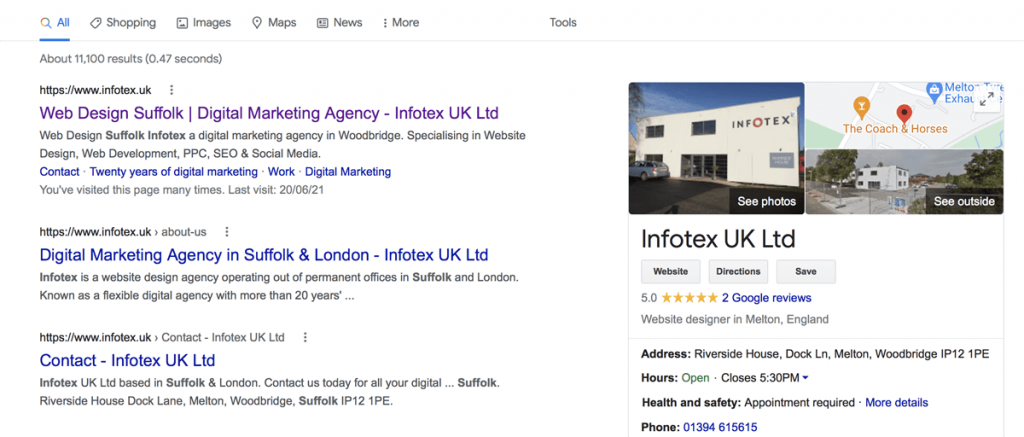
It’s also common for users to search queries including “near me” in the search bar, so it’s vital that you have your location up to date, especially if you deal in local business.
Off-site SEO refers to when Google or other search engines use information from places on the web other than your website to affect its ranking. In other words, Google looks to the rest of the internet to assess the importance of your website.
The most important of these is backlinks, that is, other website links that mention you. This has been a crucial ranking factor since Google’s inception – and things don’t look like changing. The quality of your website has to resonate across the entire web.
In this Google Search Central Podcast, a member of the Google Search Quality team specialising in spam explains how algorithms fight spam websites and websites that are at risk of being targeted by spam. Google demotes sites specifically built for spam so that they don’t show up in search results. Less than 1 percent of users land on spam pages on Google despite 40 billion spam pages showing up on Google every day.
“Ok. I found this on the web for What is Voice Search Optimisation? Check it out”, says Siri in response to my question. His voice – set to British: Male by default – is familiar to me, after a few years of hearing it. On my screen appears a list of the top results.
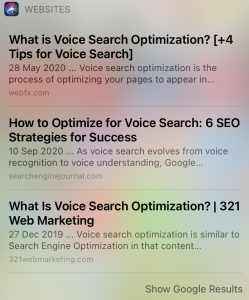
Apple’s Siri is one of the big names – along with Google Now and Amazon’s Alexa – in Voice Search Assistants. For some of us, this is all a bit spooky. Talking to our devices is the stuff of sci-fi films and the inter-human connection seemingly gone wrong. But from an SEO perspective, Voice Search is one of the most exciting trends out there.
Voice Search is the fastest rising ecommerce trend. According to the Global Web Index, over 27% of the worldwide online population was using voice search on mobile before the COVID-19 pandemic. In Great Britain, 49% of 25-34 year-old adults used a virtual assistant speaker or app from January to February 2020.
This number is now significantly higher, with lockdowns driving people to rely on their devices more than ever. This type of search is also coming to be seen as a more hygienic way of using devices: the 2020 Gartner Pandemic and Behaviours study suggests that 32% of consumers are interested in hands-free technology that would limit touching or contamination.
You might have noticed that when I asked Siri What is VSO?, I naturally asked a full-sentenced question. Unlike when we type in shorthand, when we are speaking aloud we mostly communicate whole sentences to devices, as if talking to a person.
Essentially, this means that you should include conversational language in your website copy. Of course, your website content should always be concise and highly relevant. But there should also be a large amount of it that inherently consists of natural sounding phrases, so that it will relate to certain voice search queries and be picked up by the search engine. You might have noticed that one way most businesses like to achieve having this sort of content is through the inclusion of extensive FAQ pages. This also enables them to include question words – what, why, who, etc. – in their content, which are frequently included in voice searches.
With the right written content, you are playing by the rules of search engine algorithm techniques, and your website is likely to be higher up on the search engine results. You’ll notice that, in my case with Siri, I am only offered 3 search results. It can be a tough competition then! – make sure you’re giving your business the best chance.
Voice Search Assistant technology has been developed in the knowledge that someone who is using voice search as opposed to other typed-based searches is doing so because they have less time, or seek an immediate response.
For this reason it is important to make sure your website can load fast enough and prevent your bounce-rate from increasing (something that Google would detect). Speed is something to bear in mind when writing your website content too, by making it concise and informative.
The majority of people using voice search do so from mobile devices, particularly smartphones. Not surprisingly, then, people are often physically mobile themselves when using voice search. Although it can of course be said that us private Brits are not very likely to speak out loud to our phones in very public places, we are still seeing an opening up of possibilities for local businesses due to a user’s tendency to voice search for a certain shop or amenity ‘near me’. It’s therefore important that you have your address, contact, opening hours, and any other necessary details listed correctly with the main search engines (Google, Bing, Yahoo, Yelp), so that people are directed to your business efficiently.
Voice Search is an ecommerce game-changer, and there is very little argument against optimising your business for voice search because, after all, anything you do to optimise for voice searches will also help with other aspects of your SEO business strategies.
To get advice on optimising your website, don’t hesitate to get in touch.
We’ve all been watching the world call predictive analytics to action in the wake of the current pandemic; constant data analysis is driving our predictions of how quickly the virus will spread, how long for, how it will manifest, and so on.
This isn’t the first time predictive analytics have dominated media headlines. As we have seen in recent elections, predictive analytics help election campaigners to determine potential voters – especially the undecided, yet receptive voter – by assembling analysts to interpret large-scale big data. Through this, they target their campaigns on the voters who could potentially be a ‘yes’ vote, as opposed to targeting those who would always be a ‘no’ vote.
As predictive analysis becomes evermore present in our lives, it continues to offer huge potential to drive business in the marketing world. With the growth of Big Data and Artificial Intelligence, the use of predictive analytics can help navigate unstable markets, by enabling informed decisions about future marketing and customer trends.
What is Predictive Analytics?
Predictive Analytics is the practice of extracting information from existing data sets in order to predict future outcomes and trends. It is effective in revealing opportunities and solving problems, and is used in cybersecurity, the improvement of operations and services, and in optimising marketing strategies.
In marketing terms, predictive analytics uses customer data to help businesses adapt marketing strategies to future trends, and to attract and retain their most important customers.
How can predictions benefit your marketing strategies?
Predictive analysis is your best tool in prioritising leads and retaining customers. One of our clients, Nectar360, utilises this to remain as the UK’s largest loyalty program; they make sophisticated predictions from customer loyalty cards in order to help some of the UK’s biggest brands, such as Sainsbury’s, to build impactful connections with their customers.
If you want to improve your business sales strategies, you can start with building small testing models with predictive analysis for your digital marketing, such as running a new specific advertising campaign, and examine how the data grows or changes in order to deduce how it is best to adapt your strategy. By consistently collecting and storing data – such as which device is driving the most leads, or which site features are getting the most clicks – you optimise your campaigns for better lead scoring.
You can also use predictive analytics to look at the mix of traffic on your channels, and their respective conversion rates, allowing you to model estimated sales in response to when particular channels are increased or decreased.
For an international client serving multiple markets we have been able to predict sales revenue across multiple markets, using datapoints from the website visitor behaviours to calculate conversions. Being able to see earlier and more accurately how your website is performing as a revenue-generator is invaluable to inform content marketing decisions.
Predictive Advertising
Google Ads and Facebook Ads use Machine Learning to predict which audiences are best to target, and you can set your budget to more/less, depending on how much you want to impact your sales or enquiry levels.
Many of our Google Ads campaigns utilise predictive modelling tools available from Google’s Machine Learning to predict a customer’s chance of purchasing, based on various points including their search terms, their time of day, their previous browsing and buying habits, and much more. These include exploring estimated clicks and sales based on budgets and utilising their data-driven bid strategies to predict how many sales and enquiries you can receive based on the daily budgets you are willing to spend.
Predictions in 2021: more than just guesstimating?
Usually, forecasting the year ahead in terms of sales, visits or enquiries, would be based on prediction from data of previous years and the current trends. As we look to 2021, however, an uncertain 2021 for many, this kind of analysis may not be as reliable as it has been in previous years.
Nevertheless, predictive analysis remains an important way to help businesses adapt to competitive markets, revealing trends within their email systems, advertising data, social media analytics, or website analytics.
Search Engine Optimisation is the process through which we can improve search engine traffic to your website, and find the most relevant consumers to increase conversion rates.
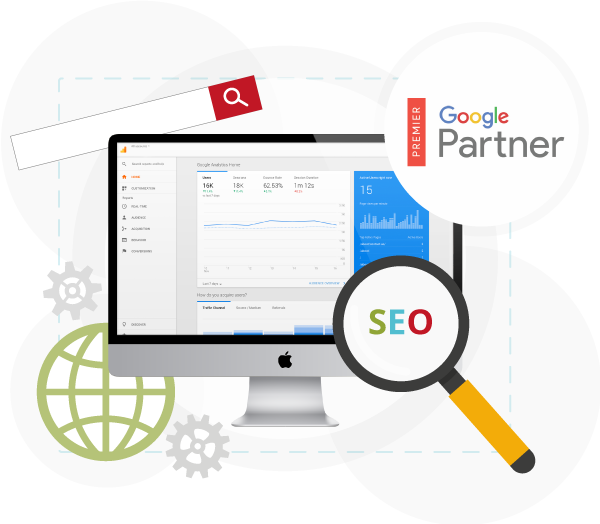
Each keyword encapsulates a business opportunity at the exact point the user shows intent. Making sure these keywords represent your business goals is the key to a successful SEO strategy. We target attainable low competition niches and track our positions continuously to give you the best search engine performance.
Our arsenal of industry leading tools allows us to understand your key competitor’s SEO stature. This sets a realistic benchmark and often reveals exciting opportunities that we feed back into your strategy. A universal strategy for every client doesn’t cut it, every industry has different SEO requirements, that’s why we conduct thorough audits in your space before we start our optimisations.
SEO never sits still. Search engines are always looking for the next best way to serve you the highest quality results for your search. We pick up on these changes in Google’s algorithm and adapt our client’s strategy to give them the greatest benefit. If you rest on your laurels you could easily see yourself dropping off the results page, what worked in 2012 would fail in 2017. Having a team with their ears to the ground, looking for these changes, is the insurance you need for your search performance security.
It doesn’t matter if we’re optimising or building – we make sure your site is set up to be Google friendly. Having a solid SEO infrastructure provides a strong foundation to build all future search engine optimisations. Combining the knowledge of our SEOs with our technically gifted development team, positions us perfectly to set you off on the right foot.
Google looks to the rest of the internet to assess the importance of your website. More specifically, they look at other websites links that mention you. This has been a crucial ranking factor since Google’s inception – and things don’t look like changing. We want the quality of your website to resonate across the web and we thrive in discovering creative ways to do so.
Discover how our team can help you on your journey.
Talk to us today